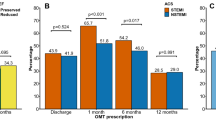Abstract
There is consensus that patients should be treated with antiplatelet agents, beta-blockers, ACE-inhibitors/ARBs, and lipid lowering drugs for secondary prevention after acute myocardial infarction (AMI), but this evidence-based pharmacotherapy is underutilized. A quality improvement program was conducted in the Austrian county of Burgenland to emphasize the importance of cardiovascular drug therapy at hospital discharge in patients with AMI. In this prospective cohort study 250 members of a regional health insurance company, Burgenländische Gebietskrankenkasse (BGKK), with AMI during the year 2003 were identified using BGKK database. Discharge prescriptions and pharmacy reimbursement data of all included patients were determined. Overall prescription rate for patients discharged from hospital after AMI (n = 207) was 86% for platelet aggregation inhibitors, 77% for ACE-inhibitors or ARBs, 72% for beta-blockers, and 68% for a lipid lowering agent including statins. The all-cause mortality rate during a mean follow-up period of 552 days was 20%. Hazard ratio (HR) for death of patients with maximum 2 medications vs. those receiving 3 or 4 medications was 2.23 (95% CI: 1.19–4.18; p = 0.012). These data demonstrate that use of evidence-based drug treatment for prevention of mortality in patients with AMI is associated with risk reduction and survival benefit. Continuous quality improvement initiatives serve to improve outcome after AMI.
Similar content being viewed by others
References
McGovern PG, Jacobs DR Jr., Shahar E, et al. (2001) Trends in acute coronary heart disease mortality, morbidity, medical care from 1985 through 1997: The Minnesota heart survey. Circulation 104: 19–4
Rosamond WD, Folsom AR, Chambless LE, Wang CH. (2001) Coronary heart disease trends in four United States communities. The Atherosclerosis Risk in Communities (ARIC) study 1987–996. Int J Epidemiol 30(Suppl 1): S17–S22
Kirchhoff M, Davidsen M, Bronnum-Hansen H, et al. (1999) Incidence of myocardial infarction in the Danish MONICA population 1982–991. Int J Epidemiol 28: 211–18
Tunstall-Pedoe H, Kuulasmaa K, Mahonen M, Tolonen H, Ruokokoski E, Amouyel P. (1999) Contribution of trends in survival and coronary-event rates to changes in coronary heart disease mortality: 10-year results from 37 WHO MONICA project populations. Monitoring trends and determinants in cardiovascular disease. Lancet 353: 1547–557
STATISTIK Austria- Jahrbuch der Gesundheitsstatistik 2004. Available at www.statistik.at/neuerscheinungen//download/2006/gesundheit 2004
Yusuf S, Sleight P, Pogue J, Bosch J, Davies R, Dagenais G. (2000) Effects of an angiotensin-converting-enzyme inhibitor, ramipril, on cardiovascular events in high-risk patients. The Heart Outcomes Prevention Evaluation Study Investigators. N Engl J Med 342: 145–53
Baigent C, Collins R, Appleby P, Parish S, Sleight P, Peto R. (1998) ISIS-2: 10 year survival among patients with suspected acute myocardial infarction in randomised comparison of intravenous streptokinase, oral aspirin, both, or neither. The ISIS-2 (Second International Study of Infarct Survival) Collaborative Group. Br Med J 316: 1337–343
Dickstein K, Kjekshus J. (2002) Effects of losartan and captopril on mortality and morbidity in high-risk patients after acute myocardial infarction: the OPTIMAAL randomised trial. Optimal Trial in Myocardial Infarction with Angiotensin II Antagonist Losartan. Lancet 360: 752–60
Freemantle N, Cleland J, Young P, Mason J, Harrison J. (1999) Beta Blockade after myocardial infarction: systematic review, meta regression analysis. Br Med J 318: 1730–737
Antman EM, Anbe DT, Armstrong PW, et al. (2004) ACC/AHA guidelines for the management of patients with ST-elevation myocardial infarction; A report of the American College of Cardiology/American Heart Association Task Force on Practice Guidelines (Committee to Revise the 1999 Guidelines for the Management of patients with acute myocardial infarction). J Am Coll Cardiol 44: E1–E211
Simpson E, Beck C, Richard H, Eisenberg MJ, Pilote L (2003) Drug prescriptions after acute myocardial infarction: dosage, compliance, and persistence. Am Heart J 145:438–44
Mukherjee D, Fang J, Chetcuti S, Moscucci M, Kline-Rogers E, Eagle KA. (2004) Impact of combination evidence-based medical therapy on mortality in patients with acute coronary syndromes. Circulation 109: 745–49
Yan AT, Tan M, Fitchett D, et al. (2004) One-year outcome of patients after acute coronary syndromes (from the Canadian Acute Coronary Syndromes Registry). Am J Cardiol 94: 25–9
Hasdai D, Behar S, Wallentin L, et al. (2002) A prospective survey of the characteristics, treatments and outcomes of patients with acute coronary syndromes in Europe and the Mediterranean basin; the Euro Heart Survey of Acute Coronary Syndromes (Euro Heart Survey ACS). Eur Heart J 23: 1190–201
Steg PG, Goldberg RJ, Gore JM, et al. (2002) Baseline characteristics, management practices, and in-hospital outcomes of patients hospitalized with acute coronary syndromes in the Global Registry of Acute Coronary Events (GRACE). Am J Cardiol 90: 358–63
Pedersen TR, Faergeman O, Kastelein JJ, et al. (2005) High-dose atorvastatin vs. usual-dose simvastatin for secondary prevention after myocardial infarction: The IDEAL study: a randomized controlled trial. Jama 294: 2437–445
Schwartz GG, Olsson AG, Ezekowitz MD, et al. (2001) Effects of atorvastatin on early recurrent ischemic events in acute coronary syndromes: The MIRACL study: A randomized controlled trial. Jama 285: 711–718
Aronow HD, Topol EJ, Roe MT, et al. (2001) Effect of lipid-lowering therapy on early mortality after acute coronary syndromes: An observational study. Lancet 357: 1063–068
Barron HV, Michaels AD, Maynard C, Every NR. (1998) Use of angiotensin-converting enzyme inhibitors at discharge in patients with acute myocardial infarction in the United States: Data from the National Registry of Myocardial Infarction 2. J Am Coll Cardiol 32: 360–67
Acknowledgements
We would like to thank all participating centres and physicians for their contribution and support.
Author information
Authors and Affiliations
Rights and permissions
About this article
Cite this article
Gouya, G., Reichardt, B., Ohrenberger, G. et al. Survival of patients discharged after acute myocardial infarction and evidence-based drug therapy. Eur J Epidemiol 22, 145–149 (2007). https://doi.org/10.1007/s10654-006-9087-9
Received:
Accepted:
Published:
Issue Date:
DOI: https://doi.org/10.1007/s10654-006-9087-9




